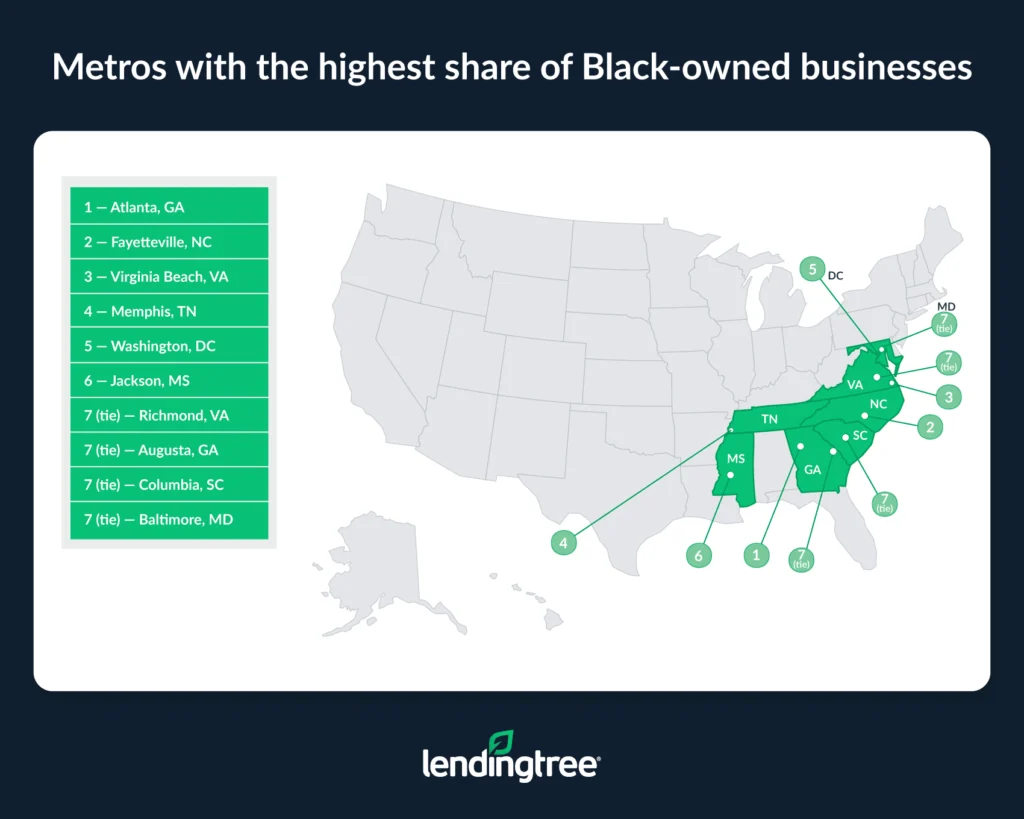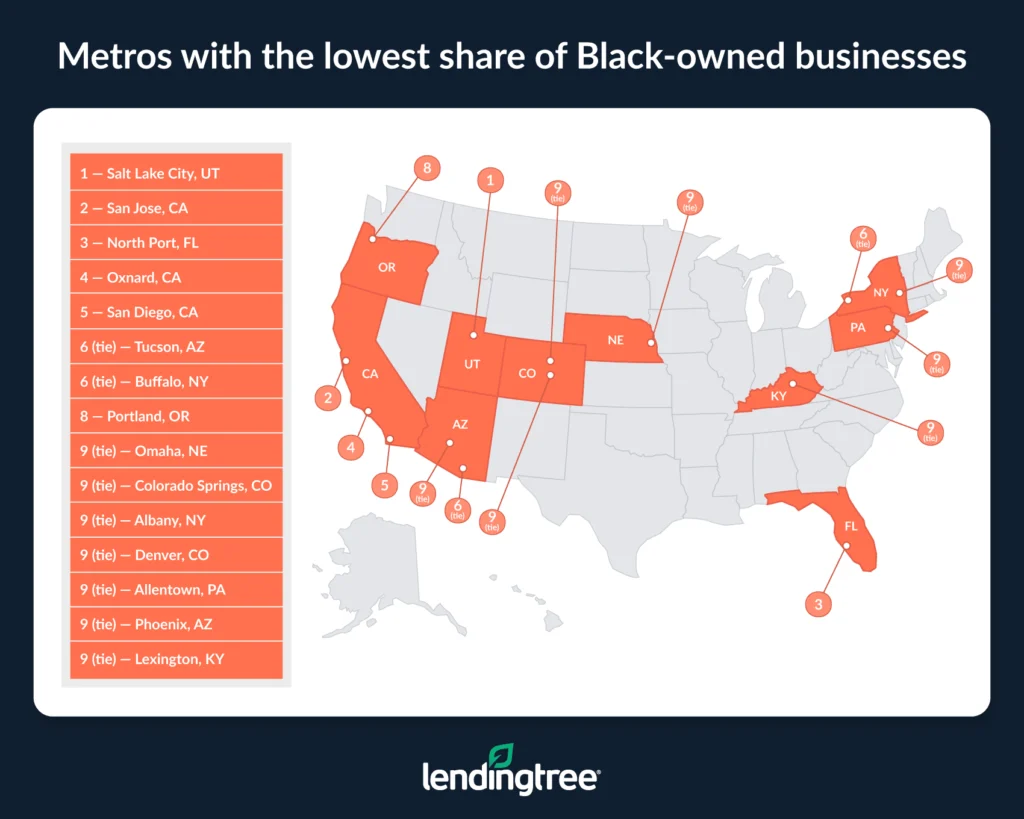Number of Black-Owned Businesses Spikes As Atlanta Remains in Spotlight
February is Black History Month, which raises awareness of the inequalities Black Americans face.
Black entrepreneurs face significant hurdles in the business world, including representation. As of 2022, only 3.3% of businesses were Black-owned.
This study looks at where Black-owned businesses are most and least common.
Key findings
- Though still small, the percentage of Black-owned U.S. businesses is up 22.2% year over year. 3.3% of businesses were Black-owned in 2022 (the latest available), up from 2.7% in 2021 and 2.4% in 2020 and 2019. A significant 39.1% of Black-owned businesses across the U.S. are run by women — far higher than the 22.3% of all businesses run by women.
- For the third year in a row, Atlanta remains the hub for Black-owned businesses. 11.3% of Atlanta businesses were Black-owned in 2022 — a significant jump from 8.8% in 2021 and 7.4% in 2020, though it ranked first both years. Fayetteville, N.C., which was No. 1 in 2019, and Virginia Beach, Va., join the top three at 10.1% and 9.4%, respectively.
- Western metros have the lowest rate of Black-owned businesses. Salt Lake City, San Jose, Calif., and North Port, Fla., are at the bottom, at 0.8%, 1.0% and 1.3%, respectively. Across the 100 metros with the most Black-owned businesses, less than 2.0% of all businesses are Black-owned in eight.
- About 1 in 4 Black-owned businesses are in the health care and social assistance industry. 25.6% of Black-owned businesses were in this industry in 2022, though that’s down from 28.0% in 2021. Professional, scientific and technical services (13.6%) and transportation and warehousing (9.2%) follow.
- Black-owned businesses run by women are likely to be young, but a significant chunk generates hundreds of thousands in sales. 30.9% of women-ran Black-owned businesses have been open for less than two years, while 19.1% have been open for just two to three years. That said, 55.2% of these businesses have between $100,000 and $999,999 a year in sales, with another 12.8% making $1 million or more.
Share of Black-owned businesses in the U.S. grew 22.2%
Just 3.3% of businesses were Black-owned in 2022, according to the latest available data. While still small, that’s up 22.2% year over year. For comparison, 2.7% of businesses were Black-owned in 2021 and 2.4% were in 2020 and 2019.
Percentage of businesses by race
Source: LendingTree analysis of 2022 data from the 2023 U.S. Census Bureau Annual Business Survey. Note: Totals don’t add to 100% due to other races outside these main breakdowns.
Matt Schulz — LendingTree chief consumer finance analyst and author of “Ask Questions, Save Money, Make More: How to Take Control of Your Financial Life” — says hard times may have driven the increase in Black-owned businesses.
“There’s no question that stubborn inflation and today’s high prices are spurring more people to seek new ways to supplement their income,” he says. “As the saying goes, necessity is the mother of invention, and it has never been easier or cheaper to start a small business than today, so it shouldn’t be a surprise that more Americans are going that route.”
Notably, more Black-owned businesses are run by women than all businesses. In fact, 39.1% of Black-owned businesses across the U.S. are run by women, while just 22.3% of all businesses are run by women.
Percentage of Black-owned businesses by gender
Source: LendingTree analysis of 2022 data from the 2023 U.S. Census Bureau Annual Business Survey. Note: The percentage of businesses doesn’t add to 100% due to unclassifiable statuses.
Atlanta continues to have the highest rate of Black-owned businesses
Looking across the 100 metros with the most Black-owned businesses, 11.3% of Atlanta businesses were Black-owned in 2022, ranking first. Comparatively, 8.8% of Atlanta businesses were Black-owned in 2021 and 7.4% in 2020. While those figures are significantly lower, Atlanta still ranked first both years.

Atlanta’s significant Black population may contribute to its rankings here. With 33.6% of residents being Black, it has the 12th-highest Black population percentage among the metros analyzed.
Fayetteville, N.C., ranks second at 10.1%. Fayetteville ranked No. 1 in 2019, though it wasn’t included in our analysis of 2020 or 2021 because of data availability. Virginia Beach, Va., rounds out the top three at 9.4%. Virginia Beach has changed rankings several times, finishing in third in 2020 and fifth in 2021.
Fayetteville has the eighth-largest Black population percentage at 37.0%, while Virginia Beach has the 18th-largest at 29.3%. Overall, each of the 10 metros with the highest share of Black-owned businesses are in the South.
Salt Lake City has the lowest rate of Black-owned businesses
Conversely, Salt Lake City has the lowest rate of Black-owned businesses at just 0.8% — the only metro below 1.0%. With just 1.6% of its residents Black, it’s the only metro with less than 2.0% of its residents Black.
San Jose, Calif., and North Port, Fla., follow, at 1.0% and 1.3%, respectively. San Jose has the third-lowest Black population percentage, at 2.4%. Meanwhile, North Port ties for 12th-lowest, at 5.9%.

Less than 2.0% of businesses are Black-owned in eight metros, six of which are in the West.
Full rankings
Percentage of Black-owned businesses by metro
Source: LendingTree analysis of 2022 data from the 2023 U.S. Census Bureau Annual Business Survey. Note: Only the 100 metros with the most Black-owned businesses were considered.
Health care and social assistance is the top industry for Black-owned businesses
By industry, health care and social assistance has the highest share of Black-owned businesses at 25.6%. That’s down from 28.0% the year prior, when it also ranked first.
Percentage of Black-owned businesses by industry
Source: LendingTree analysis of 2022 data from the 2023 U.S. Census Bureau Annual Business Survey. Note: Totals don’t equal 100% due to rounding.
For the second year in a row, professional, scientific and technical services (13.6%) had the next-highest share of Black-owned businesses. Transportation and warehousing (9.2%) jumped to third in 2022 from fifth in 2021.
Women-run Black businesses are young but profitable
Women-run Black businesses may be young, but a significant share generates high sales.
Overall, 30.9% of women-ran Black-owned businesses have been open for less than two years. Following that, 19.1% have been open for two to three years and 16.6% have been open for six to 10 years.
Percentage of Black-owned businesses by firm age
Source: LendingTree analysis of 2022 data from the 2023 U.S. Census Bureau Annual Business Survey. Note: Totals may not add to 100% due to rounding.
Still, 55.2% of these women-owned businesses make between $100,000 and $999,999 a year in sales. That’s slightly higher than the 54.7% of all Black-owned businesses with similar sales. While 12.8% of the women-owned businesses make $1 million or more, that’s less than the 17.8% of all Black-owned businesses reporting these sales figures.
Percentage of Black-owned businesses by sales
Source: LendingTree analysis of 2022 data from the 2023 U.S. Census Bureau Annual Business Survey. Note: Totals may not add to 100% due to rounding.
Schulz believes young Americans have embraced entrepreneurship far more than their older counterparts, which may be spurring high startup rates and income generation regardless of race, income level, location or other factors.
“Having experienced the Great Recession and the pandemic, either as a young professional or as a kid watching their parents struggle, millennials and Gen Zers simply aren’t willing to center their whole financial lives around one paycheck they know could go away in a moment,” he says. “They’re diving into side hustles and other opportunities to diversify their income, and that’s good. And they’re not only starting their own businesses. They’re also supporting others who do the same, and that’s a big deal, too.”
Expert tips for new Black entrepreneurs
Starting and maintaining a business is no easy feat, but you can do a few things to make it a little easier. For aspiring Black entrepreneurs, Schulz recommends the following:
- Lean on your network. “Your friends, family and loved ones want to help you,” he says. “Let them do it. In some cases, that help might be financial, but it doesn’t have to be. Mobilizing your army of supporters to help you get the word out about your businesses via social media and other means is a big deal. And, of course, emotional support matters. Being an entrepreneur is hard work. Having a supportive ear to talk to or shoulder to cry on can go a long way toward helping the small businessperson persevere.”
- Take advantage of funding opportunities and other resources. “Many organizations are dedicated to helping Black entrepreneurs succeed,” he says. “Googling ‘Black small business resources in my area’ can be a good start. This can lead to opportunities for much-needed funding, networking opportunities, training tools and much more.”
- Have a plan. Whether you’re trying to qualify for a Small Business Association (SBA) loan or calculating what size small business loan you can afford, it’s important to have a solid financial plan. Beyond that, determining your target audience, competitors, goals and more is crucial to ensuring your business can thrive.
Methodology
LendingTree researchers analyzed 2022 data from the 2023 U.S. Census Bureau Annual Business Survey to rank the metros with the highest percentage of Black-owned businesses.
Researchers first compiled the number of Black-owned businesses in the 100 metros with the most Black-owned businesses. Analysts then compared that number to the total number of businesses in each metro. The metros with the highest percentage of Black-owned businesses were ranked from highest to lowest.
Population data comes from the U.S. Census Bureau 2022 American Community Survey with one-year estimates.
Compare business loan offers
- Key findings
- Share of Black-owned businesses in the U.S. grew 22.2%
- Atlanta continues to have the highest rate of Black-owned businesses
- Salt Lake City has the lowest rate of Black-owned businesses
- Health care and social assistance is the top industry for Black-owned businesses
- Women-run Black businesses are young but profitable
- Expert tips for new Black entrepreneurs
- Methodology
Read more
Places Where Black Americans Thrive the Most (and Least) Updated August 28, 2023 LendingTree researchers found that Black households see the most economic prosperity in Washington, D.C., and…Read more
Minority Entrepreneurs Are Succeeding the Most in San Francisco and the Least in Cleveland Updated August 21, 2023 Our analysis shows that minority-owned businesses are experiencing the most success in San Francisco and…Read more

